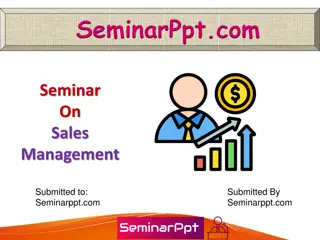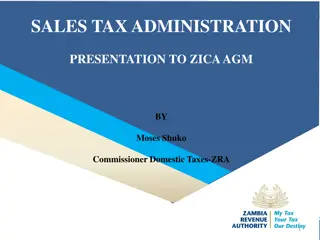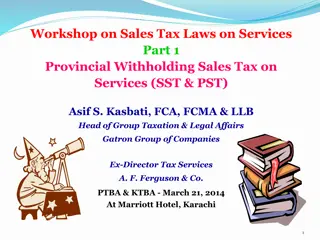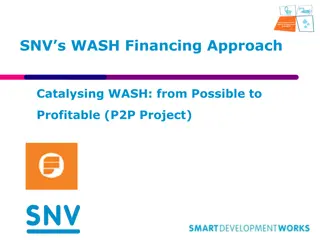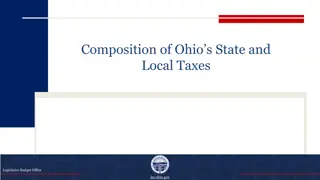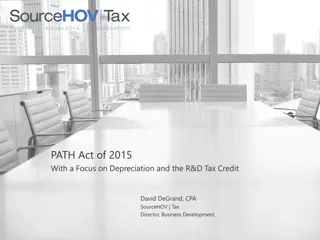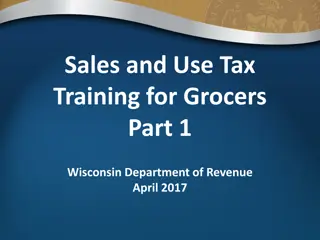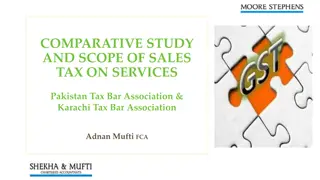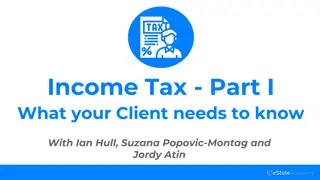Hedge Fund Tax Strategies: Wash Sales Rules and Solutions
Explore the intricacies of wash sales rules in hedge fund tax strategies, including the disallowed loss consequences, tacked-on basis adjustments, and feasible solutions like strategic fund switches and options trading to maintain economic outcomes while complying with IRS regulations.
Download Presentation

Please find below an Image/Link to download the presentation.
The content on the website is provided AS IS for your information and personal use only. It may not be sold, licensed, or shared on other websites without obtaining consent from the author. Download presentation by click this link. If you encounter any issues during the download, it is possible that the publisher has removed the file from their server.
E N D
Presentation Transcript
Revisit Hedge Fund Tax Issues and What is Working Now Mark Fichtenbaum, CPA, JD, LLM, President, MF Consulting E. George Teixeira, CPA, Partner Lisa Head, CPA, Partner-In- Charge - Investment Funds Tax Leader of Financial Services Practice Weaver LLP Clinical Assistant Professor, Pace University Anchin Block & Anchin LLP
Wash Sales, Straddles, Foreign Currencies and Straddles 2
Wash Sales IRC Sec. 1091 Wash Sale Rule Transaction covered Sell a security at a loss, and Within 30 days prior to or 30 days after such sale, substantially identical securities are purchased, then The loss is disallowed Sec. 1091(a) Tacked on basis tacked on holding period The disallowed loss is added to the basis of the purchased security The holding period of the disallowed loss position is added to the holding period of the purchased security that caused the wash sale 3
Wash Sales Facts: Investor has unrealized loss in the ABC S&P 500 mutual fund Goal recognize loss stay invested in S&P 500 4
Wash Sales Solution 1 Sell ABC S&P 500 fund and buy the DEF S&P 500 fund While underlying stocks are the same, management of the fund are by two different and distinct entities Management fees are different Stocks are exactly the same 5
Wash Sales Solution 2 A. Buy a deep in the money call option on the S&P 500 B. Buy a call and sell a put on the S&P 500 with identical strike prices and maturity 6
Wash Sales Results A. Wash sale rule does not apply Economics are preserved Loss is recognized B. Wash sale rule does apply Economics are preserved 7
Wash Sales Tax result Options are Sec. 1256 contracts Options are marked to the market at year end In effect, the disallowed loss is recognized through the year end mark Character of loss is changed Prior loss was either 100% long-term or 100% short-term Sec 1256 changes the loss to 60% long-term and 40% short-term Depending upon the facts this could be either good, bad, or indifferent 8
Wash Sales Solution 3 Sell ABC Fund and enter into some sort of derivative on a basket of securities Make sure that the stocks in the underlying fund do not overlap with 70% or more of the stocks in the basket on a capital weighted basis Basket must have at least 20 stocks 9
Wash Sales Economics Economics have shifted Taxes Under 70% very conservative meets the standard under the straddle and dividend holding period rules which typically look for substantially similar Wash sale rules have a higher standard substantially identical How much overlap can there be? <70, 75, 80 85, 90, 95???? 10
Wash Sales Facts Loss is on a single stock Strategy 1 Sell stock Buy a call on the underlying stock covering the amount of shares sold Buy the underlying stock Sell the calls 11
Wash Sales Economics Once the calls are disposed of, economics are identical Excess exposure to the underlying stock while calls are held Amount of excess is dependant upon the delta of the calls The further out of the money and shorter life span, the less the delta From the time the stock is sold until the stock is repurchased the investor has decreased its exposure to the stock 12
Wash Sales Taxes Purchase of calls trigger the wash sale rules, regardless of the strike price or time to expiry Caveat economic substance Subsequent purchase of stock does not invoke the wash sale rules with respect to original sale of stock Regulations state that FIFO is used in applying the wash sale rule 13
Wash Sales Taxes Sale of calls will trigger the recognition of the original loss of stock The purchase of the second lot of stock will not create a wash sale with respect to the sale of the calls, as long as the stock and the call options are not substantially identical Imperative that deep-in-the-money calls are not used in this strategy 14
When is the purchase of a security identical to the security sold for a loss produce a wash sale? A within 30 days after the sale B within 30 days prior to the sale C within both 30 days prior to and within 30 days after the sale 15
Turning Long-Term Capital Losses into Short- Term Capital Losses Sell stock realizing long-term capital loss Buy deep in the money call Exercise call - sell stock Results Loss on stock is disallowed Disallowed loss is added to basis of calls - still long-term Exercise of call starts new holding period 16
Straddles Straddles IRC Sec. 1092 Loss deferral rule Losses are disallowed to the extent of unrecognized gain in other leg of straddle Disallowed loss may be deducted in the following year to the extent they exceed the unrecognized gain in the other leg of the straddle in the following year 17
Straddles Straddles Problem with the loss deferral rule Assume that an investor holds 10,000 shares of stock with a FMV of $100 per share Investor purchases puts covering the 10,000 shares of stock with a strike price of $100 and a premium of $5 Price of stock doubles and the puts become worthless 18
Straddles Straddles Result: Realized loss of $50,000 on puts and unrecognized gain of $1,000,000 on stock If this is regarded as one big straddle Until $950,000 of gain is either recognized or is dissipated none of the loss may be recognized If this is regarded as 10,000 straddles each on 1 share As each share is sold, a portion of the $50,000 loss will be taken 19
Straddles Congress solution Identified straddles If a straddle is identified then In lieu of the loss deferral rule, the loss is added to the basis of the remaining leg of the straddle As portions of the remaining leg are disposed of, a portion of the loss will in effect be recognized Result in the example was to have the same effect as creating 10,000 straddles Congress helped taxpayer s in this situation 20
Straddles Planning Opportunity Straddle rules Incorporate Wash Sale and Short Sale rules When these rules were enacted investment type property typically created capital gains and losses These rules effectively stop taxpayers from creating short term capital losses and long-term capital gains However, now certain investments create ordinary income while offsetting positions are treated as capital In certain cases, straddle rules don t deal with this mismatch 21
Straddles and Foreign Currencies Planning Opportunity Enter into a straddle where one leg is treated as ordinary, and the other leg is a Sec. 1256 contract treated as 60% long term and 40% short term capital For example, a forward contract in a currency offset by a futures contract in a currency Both positions are Sec. 1256 contracts so there is no mixed straddle Identify the position as an identified straddle; allowed even though all positions are Sec. 1256 contracts 22
Constructive Sales IRC 1259 Anti-abuse section Create constructive transactions Sale and ownership do not occur for legal purposes but they are deemed to occur for tax purposes Prior to 1997 Taxpayer owned appreciated stock eg: 1,000,000 shares of IBM 0 basis, fmv $100,000,000 Taxpayer would sell 1,000,000 shares short receive $100,000,000 Taxpayer posts $100,000,000 as collateral to lender of stock; but earns rebate Taxpayer is perfectly hedged Broker lends $95,000,000 to taxpayer against the position The short sale was deemed to be an open transaction Taxpayer would eventually die Estate would get a step up in basis Estate delivers the long against the short Cash in the account pays off the debt This is too good to be true! But it was for decades 24
Constructive Sales 1996 Estee Lauder Corp. goes public In the IPO the Lauder family each lend each other shares; they sell the shares in the IPO and they are all short against the box None of the family members recognize any gain Transaction spelled out in the IPO documents Transaction reported in Newsweek About 6-9 months later Congress enacts Code 1259 25
Constructive Sales 1259 Constructive Sales If there is a constructive sale of an appreciated financial position, the taxpayer shall recognize gain as if the position was actually sold for its fair market value, and Proper adjustment shall be made in the amount of any gain or loss subsequently realized with respect to such position by reason of the constructive sale The holding period of such position shall be determined as if such position were originally acquired on the date of the constructive sale Pre-existing positions will not be eligible for step up in basis 26
Constructive Sales 1259 Definitions Appreciated financial position Any position with respect to stock, debt, or partnership interest if there would be gain if such position were sold or otherwise terminated Position means an interest, including, but not limited to, a futures, forward contract, short sale or option Exceptions Non-convertible and non-contingent debt Any position that is marked to market under any provision of the Code 27
Constructive Sales 1259 Definitions Constructive Sale Not an actual sale of property Short sale of substantially identical property Offsetting NPC with respect to substantially identical property Futures or forward contract to deliver substantially identical property If appreciated position is a short sale then the acquisition of substantially similar property Regulations to be written transactions that have the same or similar effect of the above- mentioned transactions eg: option collars 28
Constructive Sales 1259 Exception for closed transactions Dangerous to rely on full of traps If constructive sale transaction is closed by the 30th day following year end, Continues to hold the appreciated asset for an additional 60 days, and At no time during the 60 day period does the taxpayer enter into a hedge that would suspend holding period under 246 Exception to exception If the risk reducing exception is closed prior to 30 days after the year end in which the original bad transaction occurred, and All of the other requirements to meet the original exception are met then there will not be a constructive sale 29
Constructive Sales 1259 What are some of the traps? 30 days not 1 month Short must be closed by the 30th day how is a short sale closed All gains on hedge are short term 60 day test measured from closing of short Because of February, you could inadvertently use an option that has less than 30 days to expiration as a hedge not a QCC When taxpayer dies the shares will not get a step up in basis either die while short position is on, or within the period the taxpayer is trying to meet the exception- in either case the exception will not be met constructive sale will be triggered 30
Constructive Sales 1259 Tools to avoid Constructive Sales Committee reports tell the treasury to write regulations dealing with collars (options) Report states that regulations will be prospective except for abusive collars Report gives an example of a collar with a put struck at 95% and the call struck at 110% of the stock price Many practitioners believe that they would not have given an example of an abusive transaction Therefore, a collar with a 15% band, and not going out too far should be alright NYSBA submitted a proposal to allow a 20% band; this has become the industry norm 31
Constructive Sales 1259 Example of a collar Taxpayer owns stock worth $10,000,000 Taxpayer buys puts with a strike price of $9,500,000 and writes calls with a strike price of $11,500,000 Taxpayer suffers losses down to $9,500,000 and enjoys appreciation up to $11,500,000 Taxpayer can borrow against the position and buy a diversified portfolio 32
Constructive Sales 1259 Tools to avoid 1259 Pre-paid variable forward contract Taxpayer enters into a forward contract to deliver shares, but the number of shares varies with the price of the stock If the stock goes below 95% of its original value, investor delivers all of its stock; if the stock goes over 115% of its original value taxpayer delivers a number of shares that allows it to retain a 15% increase from its value at the time the forward was established Taxpayer receives cash upfront that discounts the value of the stock that the taxpayer must deliver in the future Same economics as options collar 33
Constructive Sales 1259 Taxation of tools Options Options are capital assets Straddle is created Interest capitalization rules apply If not hedging all shares use identification Borrow some money against the position, then borrow more money against the new position 34
Constructive Sales 1259 Taxation of tools Pre-paid variable forward contracts Straddle rules apply Interest is buried in the transaction; by its terms it is capitalized 35
Constructive Sales 1259 Closing out hedges Two basic choices Deliver stock Settle in cash Stock increases Deliver stock recognize long term capital gain on the net economic gain of both the stock and the hedge combined Settle for cash if gain short term and recognized; if loss long term and deferred Stock decreases Deliver stock recognize gain on stock long term Settle for cash recognize gain on hedge short term 36
Constructive Sales 1259 Closing out hedges Planning Compare gain on hedge vs. gain on stock to decide how to close out hedge 37
Constructive Sales 1259 Anschutz Entered into a 10 year 100-150 collar Lent shares to counter-party By way of background 10 years was used because a new S Corp did the transaction Tax court holds against Anschutz 38
Constructive Sales 1259 Anschutz Court found that Anschutz did not violate Sec. 1259 Court found that Anschutz had a taxable transaction because the lending of the stock did not meet the requirements of Sec. 1058 The Court combined the pre-paid forward contract and the stock loan As such, Anschutz entered into a stock loan agreement that reduced its profit potential and risk of loss in the stock being lent Court found that the amount realized was the cash that Anschutz received, not the fair market value of the underlying stock 39
Tax Planning using 1259 Assume that you have substantial unrealized gains in your portfolio which have aged to Long Term ( LT ) and you would like to buy some more time in order to decide when to recognize the capital gain You can enter into an offsetting position and cause a constructive sale and potentially realize the gain in 2021. If the status of your tax picture for 2021/2022 is more clear towards the end of January 2022, you still have time to : o Unwind the constructive gain(s) by utilizing the short term hedging exception thereby continuing to defer the LT unrealized gains to 2022 and beyond. If the status of your tax picture for 2021/2022 is more clear by early to mid-March 2022, you still have time to : o Violate the 60-day un-hedged portion of the short term hedging exception in order to recognize the constructive gain(s) in 2021. 40
Is a constructive sale a real sale of securities? A yes B no C sometimes 41
Swaps 42
Swaps Tax treatment governed by IRC Section 446 Bullet SWAPs or forwards capital gain treatment upon settlement Other SWAPs Notional Principal Contracts Periodic Payment Ordinary treatment Termination Payment Capital gain treatment Trader v. Investor Funds 162 Amounts taken into account include period payments and MTM are ordinary & necessary business expenses for a trader 212 Amounts taken into account include period payments and MTM are subject to 2% AGI floor limitation for an investor Contract by contract? So periodic payments received are taxable but periodic payments made are not deductible?!?!? This directly contradicts the final 1994 NPC regs which provide that the net expense from a swap be deductible from gross income 43
Allocations 44
Allocations Book and Tax Capital Distinction must be made between a partner s book and tax capital accounts. Outside basis IRC Section 722 Inside basis IRC Section 723 In securities partnerships, this relationship gets tricky due to unrealized gains and losses Timing differences create disparities in book and tax capital which must be considered when allocating gains and losses from trading Basic concept the book-tax disparity is the partner s personal cumulative unrealized gain or loss since he entered the fund. 45
Aggregation for reverse 704(c) allocations General concept is to allocate gains based on the differences between each partner s book capital accounts and tax basis capital accounts. Full or partial netting may be used. 46
Aggregation Full Netting Under the full netting approach, on the date of each capital account restatement, the partnership: Nets its book gains and losses from Qualified Financial Assets since the last capital account restatement and allocates the net amount to its partners; Nets tax gains and losses from QFAs since the last capital account restatement; and Allocates the net tax gain or net tax loss to the partners in a manner that reduces the book-tax disparities of the individual partners. 47
Aggregation Partial Netting Under the partial netting approach, on the date of each capital account restatement, the partnership: Nets its book gains and losses from QFAs since the last capital account restatement and allocates the net amount to its partners; Separately aggregates all tax gains and tax losses from QFAs since the last capital account restatement; and Separately allocates the aggregate tax gain and aggregate tax loss to the partners in a manner that reduces the disparity between the book and tax capital account balances of the individual partners. 48
Fill Up or Fill Down Provisions Commonly referred to as stuffing Prevents a withdrawing partner from recognizing gain or loss under IRC Section 731(a) by causing the partner s outside basis to equal the amount of cash he receives in liquidation of his interest. May be gains only read the Limited Partnership Agreement, generally in the section titled, Allocations for Tax Purposes 49
Aggregation Step Process 1st allocate items of ordinary income and expense by a reasonable method; weighted average capital, monthly, quarterly, yearly 2nd allocate capital gains/losses to liquidating partners to keep tax basis in line with book basis 3rd allocate remaining capital gains/losses in a manner that minimizes book-tax disparities for each account Capital losses 1st allocated among partners with negative disparities, up to the point where the disparity equals zero; Capital gains are allocated among partners with positive disparities, up to the point where the disparity equals zero; Remainder allocated among partners based on a reasonable method such as book income or average capital. 50
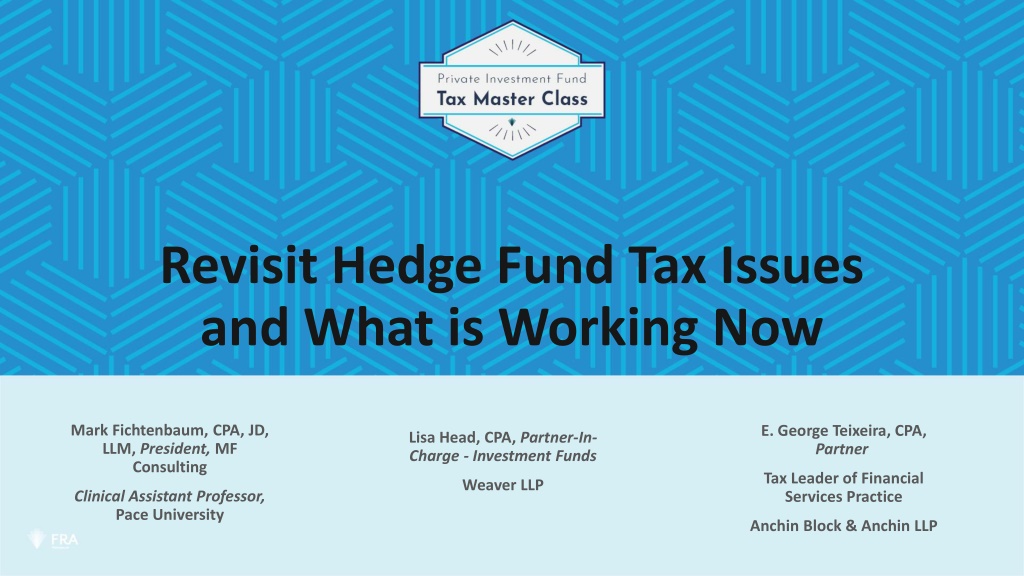





![Town of [Town Name] Real Estate Tax Rates and FY 2024 Budget Summary](/thumb/62211/town-of-town-name-real-estate-tax-rates-and-fy-2024-budget-summary.jpg)



